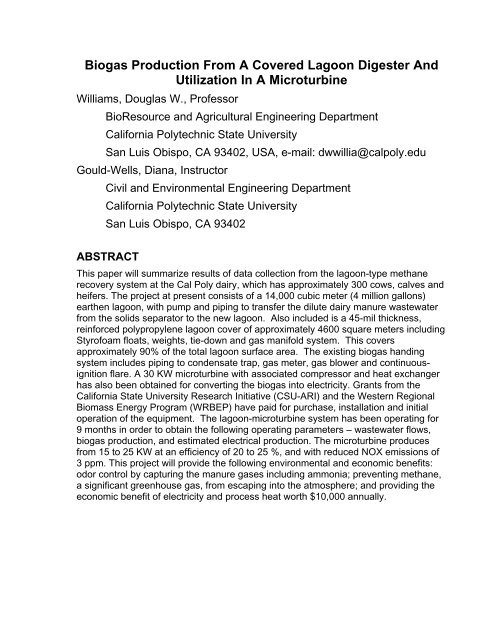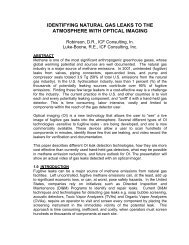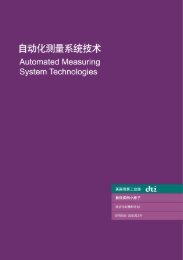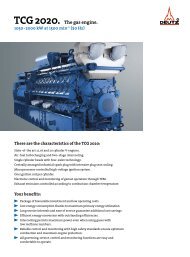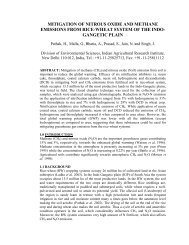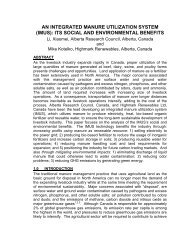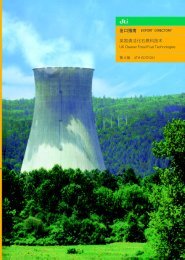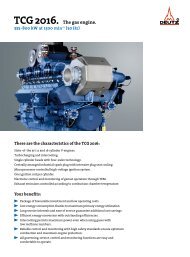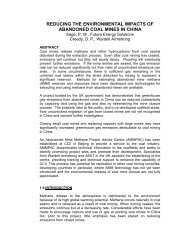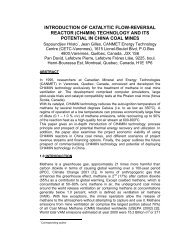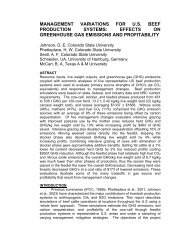Biogas Production From A Covered Lagoon Digester And Utilization ...
Biogas Production From A Covered Lagoon Digester And Utilization ...
Biogas Production From A Covered Lagoon Digester And Utilization ...
You also want an ePaper? Increase the reach of your titles
YUMPU automatically turns print PDFs into web optimized ePapers that Google loves.
<strong>Biogas</strong> <strong>Production</strong> <strong>From</strong> A <strong>Covered</strong> <strong>Lagoon</strong> <strong>Digester</strong> <strong>And</strong><br />
<strong>Utilization</strong> In A Microturbine<br />
Williams, Douglas W., Professor<br />
BioResource and Agricultural Engineering Department<br />
California Polytechnic State University<br />
San Luis Obispo, CA 93402, USA, e-mail: dwwillia@calpoly.edu<br />
Gould-Wells, Diana, Instructor<br />
Civil and Environmental Engineering Department<br />
California Polytechnic State University<br />
San Luis Obispo, CA 93402<br />
ABSTRACT<br />
This paper will summarize results of data collection from the lagoon-type methane<br />
recovery system at the Cal Poly dairy, which has approximately 300 cows, calves and<br />
heifers. The project at present consists of a 14,000 cubic meter (4 million gallons)<br />
earthen lagoon, with pump and piping to transfer the dilute dairy manure wastewater<br />
from the solids separator to the new lagoon. Also included is a 45-mil thickness,<br />
reinforced polypropylene lagoon cover of approximately 4600 square meters including<br />
Styrofoam floats, weights, tie-down and gas manifold system. This covers<br />
approximately 90% of the total lagoon surface area. The existing biogas handing<br />
system includes piping to condensate trap, gas meter, gas blower and continuousignition<br />
flare. A 30 KW microturbine with associated compressor and heat exchanger<br />
has also been obtained for converting the biogas into electricity. Grants from the<br />
California State University Research Initiative (CSU-ARI) and the Western Regional<br />
Biomass Energy Program (WRBEP) have paid for purchase, installation and initial<br />
operation of the equipment. The lagoon-microturbine system has been operating for<br />
9 months in order to obtain the following operating parameters – wastewater flows,<br />
biogas production, and estimated electrical production. The microturbine produces<br />
from 15 to 25 KW at an efficiency of 20 to 25 %, and with reduced NOX emissions of<br />
3 ppm. This project will provide the following environmental and economic benefits:<br />
odor control by capturing the manure gases including ammonia; preventing methane,<br />
a significant greenhouse gas, from escaping into the atmosphere; and providing the<br />
economic benefit of electricity and process heat worth $10,000 annually.
1.0 INTRODUCTION<br />
The total manure produced by dairy cows in the state of California is 33,000,000<br />
tons/year. As presently handled, dairy manure produces undesirable odors, biogas,<br />
and nutrient overloads resulting in air and water pollution. California Polytechnic<br />
State University (Cal Poly) has devised a system at its dairy to capture methane, a<br />
naturally emitted manure biogas, and convert it into a usable energy source to<br />
create electric power. By incorporating a <strong>Covered</strong> <strong>Lagoon</strong> <strong>Digester</strong> System with a<br />
Microturbine Electric Generation System, manure’s undesirable byproducts can be<br />
transformed into valuable assets for a dairy farmer. If the total manure produced by<br />
dairy cows in the state of California could be converted to methane, the theoretical<br />
energy production would be 20 trillion BTU which would be enough to power a 200-<br />
megawatt power plant. At the Cal Poly dairy, about 90 percent of the manure is<br />
deposited on concrete, flushed through a solids separator, and pumped into a<br />
14,400 cubic meter covered lagoon. As the manure is anaerobically digested by<br />
bacteria located at the bottom of the lagoon, methane is produced and is trapped<br />
underneath a floating cover, collected, and piped over to be used to fuel a 30 kW<br />
microturbine electric generator. Figure 1 shows the system that is installed at the<br />
Cal Poly dairy, and the specific information on the design and construction of the<br />
covered lagoon digester and methane collection system was discussed in detail by<br />
Williams and Frederick (2001) and Williams and Hunn (2002).<br />
2.0 OBJECTIVES<br />
2.1 The first objective of this paper will be to report on the baseline operating<br />
parameters of the CLDS in treating flushed dairy manure.<br />
2.2 The second objective is to determine the operating characteristics of the<br />
30 KW Microturbine Electric Generation System when fueled with biogas<br />
from the <strong>Covered</strong> <strong>Lagoon</strong> <strong>Digester</strong> System.<br />
2.3 The third objective is to estimate the energy and environmental benefits<br />
of the combined systems.<br />
3.0 PROCEDURES<br />
3.1 BASELINE OPERATING PARAMETERS OF THE COVERED LAGOON<br />
DIGESTER<br />
3.1.1 LAGOON DIGESTER VOLUME – Based on the length, width, and<br />
depth of the lagoon as measured in meters.<br />
3.1.2 INFLUENT FLOW RATE – Rate of the flushed manure entering<br />
the lagoon as measured in liters.<br />
3.1.3 HYDRAULIC RETENTION TIME – Volume of the lagoon divided<br />
by the daily influent flow as measured in days.<br />
2
Figure 1. Microturbine Electric Generator System and <strong>Covered</strong> <strong>Lagoon</strong><br />
<strong>Digester</strong> System<br />
3
3.1.4 AVERAGE BIOGAS PRODUCTION – Average production of<br />
biogas as measured in cubic meters per day.<br />
3.1.5 METHANE CONCENTRATION IN BIOGAS – <strong>Biogas</strong><br />
concentration as measured as measured in percent by volume.<br />
3.1.6 LAGOON DIGESTER TEMPERATURE – Average temperature of<br />
the lagoon contents as measured in degrees C.<br />
3.1.7 INFLUENT COD CONCENTRATION – Chemical Oxygen Demand<br />
as measured in milligrams per liter.<br />
3.1.8 EFFLUENT COD CONCENTRATION – Chemical Oxygen<br />
Demand as measured in milligrams per liter.<br />
3.1.9 COD REDUCTION – Reduction in COD from influent to effluent as<br />
measured in percent.<br />
3.1.10 OTAL AND VOLATILE SOLIDS PERCENTAGE – Percent of dry<br />
solids in the influent and percent of organic solids in the dry solids.<br />
3.1.11 INFLUENT AND EFFLUENT LAGOON PH<br />
These baseline parameters were continuously measured during a period of time<br />
from January 1, 2002 through May 31, 2002. A more complete explanation behind<br />
the measurement of these parameters can be found in Hunn (2002) and Williams<br />
and Hunn (2002). The average daily values for these parameters are listed in<br />
Table 1.<br />
Table 1. <strong>Covered</strong> <strong>Lagoon</strong> <strong>Digester</strong> Baseline Operating Parameters<br />
Parameter Average Value Units<br />
<strong>Lagoon</strong> Volume 14400 m 3<br />
Influent Flow Rate 365,000 l./day<br />
Hydraulic Retention Time 40 days<br />
Average <strong>Biogas</strong> <strong>Production</strong> 127 m 3 /day<br />
Methane Concentration 55 %<br />
<strong>Lagoon</strong> Temperature 15<br />
Influent COD Concentration 4300 mg/L<br />
Effluent COD Concentration 1800 mg/L<br />
COD Reduction 59 %<br />
Total Solids 0.5 %<br />
Volatile Solids 0.4 %<br />
Influent pH 7.64<br />
Effluent pH 7.04<br />
o C<br />
4
3.2 OPERATING CHARACTERISTICS AND FIELD TESTING<br />
The following section describes the microturbine performance from July 1, 2002<br />
through March 2003. Table 2 summarizes the results of this testing, showing<br />
biogas utilized, microturbine kilowatt setting, and kilowatt-hours generated. The<br />
data can be divided into roughly 1-month periods, during which times the<br />
microturbine power setting was maintained at specific KW levels.<br />
During the first part of July 2002, when the power was set at 15 KW, the average<br />
daily running time was 3.6 hours, the biogas consumption was 44 cubic meters per<br />
day, and the net electrical output was just over 28 kwhrs. When the power setting<br />
was increased to 20 KW later in July, the daily running time dropped slightly to 3.4<br />
hours, the biogas consumption increased to almost 54 cubic meters per day, and<br />
the net kwhrs increased dramatically to 47 kwhrs per day. When the setting was<br />
raised to 25 KW, the average daily running time dropped dramatically to 2.4 hours,<br />
accompanied by a drop in biogas consumption to 38 cubic meters per day and a<br />
net electrical production of only 31 kwhrs per day. The microturbine was then reset<br />
to 15 KW, and the resulting daily hours, biogas, and net electricity were only 1.6<br />
hours, 22 cubic feet and 14 kwhrs respectively. In comparison with the baseline<br />
parameters in Table 1, where over 100 cubic meters per day were reported, the<br />
biogas production after July 2002 was markedly lower. Reasons for this change<br />
are addressed later in this section of the paper.<br />
Table 2. Microturbine Performance Summary<br />
Time Period<br />
Hours/Day of<br />
Operation<br />
Ave. KW<br />
Microturbine<br />
setting<br />
m 3 /day <strong>Biogas</strong><br />
Kwhrs/day Net<br />
Energy<br />
July 1-9, 2002 3.6 15 44 28.<br />
July 25-Aug 8, 2002 3.4 20 54 47.<br />
Aug 9-18, 2002 2.4 25 38 31<br />
Aug19-Sept 19, 2002 1.6 15 22 14.<br />
October 2002 1.4 15 13 12<br />
November 2002 1.6 15 20 14<br />
December 2002 2.7 15 29 25<br />
January 2003 4.0 15 32 36<br />
February 2003 3.7 20 34 47<br />
March 2003 15 15 127 143<br />
5
During the initial 2-1/2 month testing phase, the microturbine was set to run as<br />
many hours per day as there was biogas available. In almost all instances, the<br />
reason for the microturbine shutting down was a “fuel fault” reading shown on the<br />
control panel. The situation that would trigger this readout was a drop in the Btu<br />
value of the biogas, due to possible air intrusion as the biogas was depleted from<br />
under the lagoon cover. This air intrusion would occur when the microturbine<br />
compressor was pulling biogas from under the cover at a slight negative pressure.<br />
It was also suspected that biogas was being lost from the same leak points that air<br />
intrusion occurred. <strong>Biogas</strong> leaking would occur when the microturbine was off, and<br />
a slight positive pressure under the cover would be forcing some of biogas out<br />
through the leak points. One of the suspected leak points was the soil under the<br />
area where the cover was attached to the lagoon bank. In order to correct this<br />
situation, a second plastic sheet was placed on the ground under the lagoon cover<br />
at the attachment area on the bank of the lagoon.<br />
Low microturbine production was experienced during the months of September and<br />
October 2002 because the covered lagoon liquid level was lowered by two feet<br />
during those months in anticipation of heavy rainfall in November and December<br />
that could exceed the runoff capacity of the overflow lagoon. When the level of the<br />
covered lagoon was lowered to this extent, it resulted in the outlet pipe’s being<br />
above the level of the lagoon. Therefore, since the lagoon level was below the<br />
outlet to the overflow lagoon, the only way to remove liquid from the covered lagoon<br />
was via the recycle pump which had its inlet in the exit area of the covered lagoon.<br />
Later in November, when the lagoon level was restored to its full capacity, the<br />
biogas production, and thus microturbine performance, increased, as shown in<br />
Table 2. Yet, even this increase was not as high as the production achieved during<br />
the initial testing in the summer months, and this was due in part to the lower<br />
lagoon temperatures in November and December (~15 o C) compared with July and<br />
August (~21 o C).<br />
One very interesting result of the microturbine testing was observed in December<br />
2002. On December 17 biogas utilization peaked at 100 cubic meters, as did net<br />
electrical output at almost 100 kwhrs. Because a very heavy rainfall occurred on<br />
the 17 th , and this resulted in significant water accumulation on the lagoon cover, it is<br />
speculated that this water pushed the lagoon cover down onto the water surface<br />
such that the biogas was forced to migrate to the Styrofoam cells and thus to the<br />
gas manifold at the lagoon bank.<br />
<strong>From</strong> the maximum observed in mid-December, biogas utilization and resulting<br />
electrical production began to fall, and in January 2003 the average hourly use was<br />
4.0 hours per day, at a setting of15kW. This resulted in an average biogas<br />
6
production of 32 cubic meters per day, with a net energy production of 36 kwhr/day.<br />
In February 2003, hourly usage averaged 3.7 hours at a setting of 20 kW. The<br />
resultant biogas production averaged 34 cubic meters, and produced a net energy<br />
production of 47.0 kwhr/day. The change from 15 kW to 20 kW between January<br />
and February 2003, and the resultant increase in net kwhr/day, shows a more<br />
efficient utilization of the biogas.<br />
During the first week of March 2003, it was discovered that the biogas pipeline was<br />
partially blocked by a dirty flame check. This blockage was subsequently removed,<br />
and as a result, the hourly usage, the biogas consumption, and kwhrs production<br />
increased dramatically to over 15 hours/day, over 127 cubic meters/day, and 143<br />
kwhrs/day, respectively. These performance figures compare favorably with the<br />
baseline gas production reported in Table 1. To measure exhaust emissions from<br />
the microturbine, tests were run on August 16, 2002 when the microturbine was set<br />
at 25kW power output. Table 3 summarizes these test results along with<br />
performance data at 15 kW and 20 kW power settings.<br />
Table 3. Microturbine Performance at 3 Different Power Settings and<br />
Emissions at 25 KW<br />
Microturbine Power 15 kW 20 kW 25 kW<br />
Setting<br />
Hours of Operation 4.15 hrs 4.5 4.34<br />
<strong>Biogas</strong> @57% Methane 59 m 3 73 m 3 82 m 3<br />
Microturbine Efficiency 20% 23% 25%<br />
Exhaust Emissions<br />
NOx<br />
3 ppm<br />
CO<br />
200 ppm<br />
3.3 ENERGY AND ENVIRONMENTAL BENEFITS<br />
The overall goal of this project is to recover as much energy as possible from the<br />
waste of the dairy cows and re-incorporate that energy back into the Cal Poly<br />
electrical grid for the benefit of the dairy. Cal Poly’s dairy produces a monthly<br />
electric bill of almost $3,000, which results in a yearly expenditure of nearly<br />
$35,000. When the Microturbine Electric Generation System is operating at its<br />
optimal performance rate, the predicted energy production of the microturbine<br />
system is just over 52,000 kWh per year. This energy, at a rate of $0.12 per kWh,<br />
is worth about $6,240 which is about 18% of the dairy’s yearly energy costs.<br />
7
In addition to the above electrical output, when operating at the optimal run time of<br />
15 hours per day, the exhaust heat energy produced by the microturbine can be<br />
recovered at a rate of 100,000 Btu/hr and is worth about $3,300 annually when<br />
compared to the average $6 per 1 million Btu cost of natural gas. The total<br />
economic benefits of the Microturbine Electric Generation System, including<br />
electricity and process heat, can then be estimated to be worth ~$10,000, or about<br />
28% of the Cal Poly dairy’s $35,000 annual electrical usage.<br />
The actual energy production of the Microturbine Electric Generation System, as<br />
explained above, falls well below the anticipated production which was expected to<br />
be between 40% to 50% of the energy needed for the Cal Poly dairy. Primarily<br />
because of design flaws in the lagoon cover, less methane was able to be collected<br />
than originally calculated, and a properly designed operations system should be<br />
able to maximize the energy and heat production of the microturbine system.<br />
The environmental benefits of a <strong>Covered</strong> <strong>Lagoon</strong> <strong>Digester</strong> System, although not<br />
quantified in a measurable economic value, are considerable. By virtue of the<br />
cover capturing the gas emissions from the dairy manure, both odor and the<br />
release of greenhouse gases are considerably reduced. Methane is a very potent<br />
greenhouse gas and is twenty-one times stronger than carbon dioxide. The<br />
methane emissions from the dairy at Cal Poly can be calculated as being almost<br />
100 pounds per day or 18 tons per year and is therefore equivalent to over 380 tons<br />
of carbon dioxide per year. It is anticipated that in the future greenhouse gas<br />
credits will be available to the dairy farmer, and the farmer will be paid for capturing<br />
methane from a dairy lagoon.<br />
4.0 CONCLUSIONS AND RECOMMENDATIONS<br />
The conclusions and recommendations that can be reached from the results of this<br />
study are the following:<br />
4.1 The greatest restriction on energy production of the microturbine system is<br />
the amount of methane available as fuel. In order to maximize methane<br />
production, a consistent flow of influent liquid entering the digester lagoon<br />
is necessary.<br />
4.2 Inconsistencies in the influent flow rate can potentially cause large<br />
fluctuations in the digester lagoon level, and therefore affect the hydraulic<br />
retention time of the liquid. Consistent influent flow will increase the<br />
hydraulic retention time and allow for increased production of methane.<br />
8
4.3 Increasing the amount of livestock in the dairy would also increase the<br />
amount of animal waste. This, in turn, would increase the volatile solids<br />
concentrations since the amount of flush water would not increase. An<br />
increase in volatile solids would increase methane production considerably.<br />
4.4 Increased conversion rates of the volatile solids into methane would<br />
improve overall methane production rates. Improved conversion rates can<br />
be accomplished by introducing heat into the liquid or by mixing the liquid in<br />
the lagoon. While mixing would be nearly impossible in a lagoon of this<br />
size, heating the lagoon contents would not be as difficult. In fact, the<br />
exhaust heat produced by the microturbine would be the perfect heating<br />
source, and it could be sent directly back into the digester lagoon via the<br />
heat exchanger installed next to the microturbine. The next phase of this<br />
project will be to set up the system to test this heating concept.<br />
4.5 Several methods might be used to minimize air intrusion into the lagoon<br />
digester system, thus improving the quality of the biogas. An anticipated<br />
improvement for this project will be to incorporate a bank-to-bank cover on<br />
the lagoon digester. In the current configuration, about 90% of the lagoon<br />
is covered, leaving small areas where the valuable methane can escape.<br />
5.0 ACKNOWLEDGEMENTS<br />
The authors gratefully acknowledge the California State University Research<br />
Initiative (CSU-ARI) and the Western Regional Biomass Energy Program (WRBEP)<br />
for providing funding for purchase, installation and initial operation of the equipment<br />
utilized at the Cal Poly <strong>Covered</strong> <strong>Lagoon</strong> <strong>Digester</strong>.<br />
6.0 REFERENCES<br />
Hunn, David. 2002. Operations Design and Evaluation of Cal Poly Dairy methane<br />
collection system. Unpublished Senior Project, Bio Resource and<br />
Agricultural Engineering Dept., Cal Poly, San Luis Obispo, CA.<br />
Johnson, E. 2002. Personal communication about Cal Poly Dairy annual electrical<br />
usage. Cal Poly Energy & Utilities Manager, San Luis Obispo, CA. February<br />
12, 2002.<br />
Williams, D.W., Frederick, J. J. 2001. Microturbine Operation with <strong>Biogas</strong> from a<br />
<strong>Covered</strong> Dairy Manure <strong>Lagoon</strong>. Presented at the 2001 ASAE Annual<br />
International Meeting, held in Sacramento, California on July 30-August 1.<br />
Pp. 1-8.<br />
Williams, D. W. and Hunn, D. 2003. Western Regional Biomass Energy Program,<br />
DOE, Final Report: <strong>Biogas</strong> <strong>Production</strong> from a <strong>Covered</strong> Dairy <strong>Lagoon</strong><br />
<strong>Digester</strong> and <strong>Utilization</strong> in a Microturbine<br />
9


